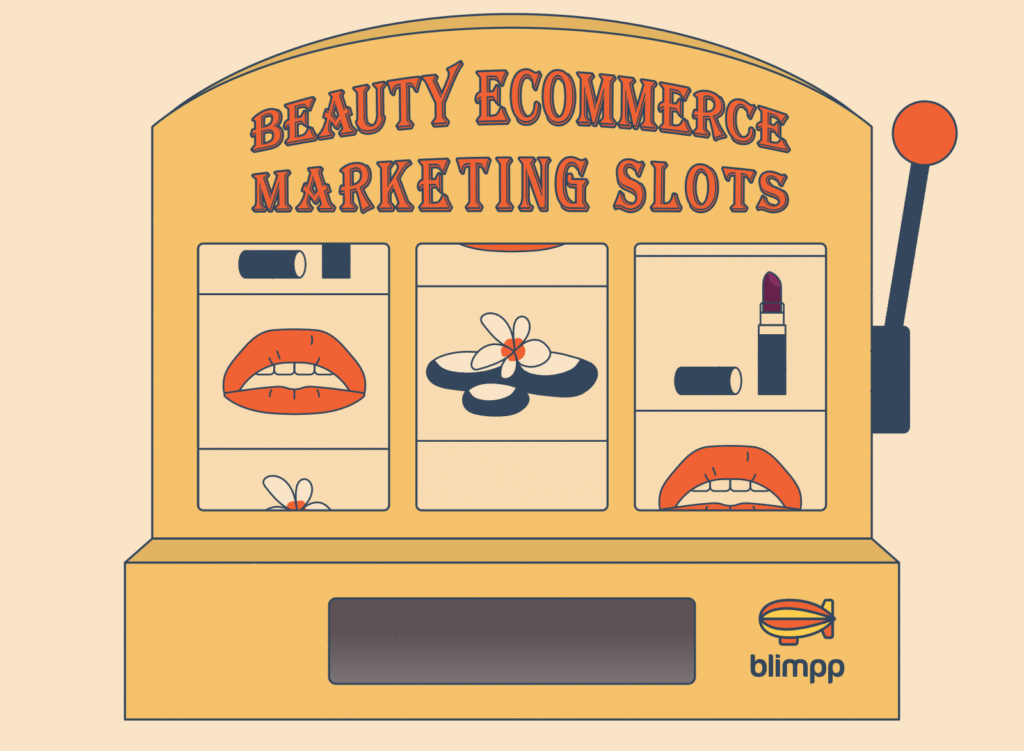The COVID-19 crisis has been a catalyst for eCommerce, accelerating the shift to online shopping, and underpinning exactly why it’s important for brands to have a direct relationship with their customers.
This is especially true within the beauty and cosmetics vertical. Before the pandemic, you could slice eCommerce into two main categories: essentials and non-essentials. Essentials representing basic products (think – food, water, paper products etc.) that are necessary to live our everyday life at a minimum, while non-essentials represent everything else.
However, due to the stay-at-home mandates that accompanied the pandemic, consumers had to adapt to the new status quo. As a result, priorities and needs have changed, bringing about a third category: new essentials – items that help you feel more comfortable at home.
The beauty and cosmetics vertical falls under this category and, as such, is one of the eCommerce sectors that has recorded parabolic levels of growth since 2020.
According to a research report by McKinsey, in China, online revenue for beauty industry players rose by 20 to 30% during the pandemic. Closer to home, blimpp client Augustinus Bader saw revenue increase from $7m in 2018 to $70m.
And with such growth in demand, it’s no surprise that more and more beauty brands are springing up, with brands working overtime to stand out.
And standing out in a sea of competition is perhaps more difficult than ever. Whether your end game is profitability, growth, or being acquired by an industry heavyweight, the challenge remains the same – scaling brand awareness, executing marketing campaigns that resonate, increasing brand loyalty, and ultimately – increasing revenue.
To achieve sustainable growth for your beauty brand, you must consider three metrics: visitors, conversion rate, and lifetime value. By successfully moving the needle on at least one of these three variables, you can be sure to increase revenue and scale ROI.
Below are the levers that we use to grow these three areas:
Sign up to our free Google Ads email course.
7 days, 7 lessons. Everything from how to structure your Google Smart Shopping campaigns to ad testing, and YouTube ads excellence. Sign up and level up your Google Ads eCommerce game.
1. Beauty eCommerce Marketing: Driving Awareness Through Social Media, Influencer Marketing & Search Engines
They say beauty is in the eye of the beholder. Well, in this case, beauty is in the eye of the buyer. And for Direct-to-Consumer eCommerce brands, visibility isn’t just about building brand awareness, it’s about being highly relevant to your target audience. For example, speaking to a particular segment of your overall audience through imagery, offer, and tone of voice that aligns across marketing touchpoints.
Speaking of marketing touchpoints, one of the key challenges for emerging beauty brands is to get your traffic mix right.
For example, most DTC eCommerce beauty brands invest heavily in paid social ads to scale initial awareness. It’s easy to see why – the average person spends an hour and 40 minutes per day on social media, and targeting capability based on interests, preferred brands, and shopping behaviour is entirely possible. So for an early-stage DTC eCommerce brand, your traffic mix (based on website sessions) might look something like this:
- Paid Social: 50%
- Paid Search: 20%
- Organic & Direct: 10%
- Email: 10%
- Other: 10%
However, as you begin to scale your reliance on certain channels also flexes. Mature DTC brands tend to see a higher proportion of traffic from paid search, email, and organic sources, and comparably less from paid social.
1. Leveraging Paid Social Ads To Reach Consumers
With the ability to target your audience based on interests, preferred brands, shopping behaviour etc., paid social ads can help you to build visibility at an alarming rate.
Facebook remains the largest platform in terms of social ads, so let’s take a brief look at each step within the campaign execution workflow of a Facebook campaign.
Step 1: Objective setting
Understanding what profitable Cost per Acquisition looks like is all-important to scaling paid social as a channel. Understanding customer lifetime value is a useful starting point when considering profitable customer acquisition. For example, if your Average Order Value is $100 and customers typically purchase 4 times over the course of their relationship with you, then you can assume that your LTV is $400. Assuming that you don’t want to spend more than 25% of the value of a product to acquire a customer, your Cost Per Acquisition target would be $100.
For emerging brands, it’s difficult to set acquisition goals based on customer lifetime value, as you simply won’t have that level of insight. But the basic mechanisms remain the same:
- Take your Average Order Value.
- Work out your desired Cost Of Sale.
- Put the two together: $100 AOV * 25% Cost Of Sale = $25 Cost Per Acquisition target.
Set goals that allow you room to acquire customers at scale. You might also want to adopt specific acquisition cost targets for individual hero products or specific product categories, where you notice that AOV and Conversion Rate may fluctuate significantly from your average.
Step 2: Plan and structure your ad account
Keep the number of ads you have running at a time manageable. With too many ads, you run the risk of eating away your budget, and you won’t be able to scale. The below structure works well as a starting point, but you might want to amend based on AOV and Conversion Rate by product category:
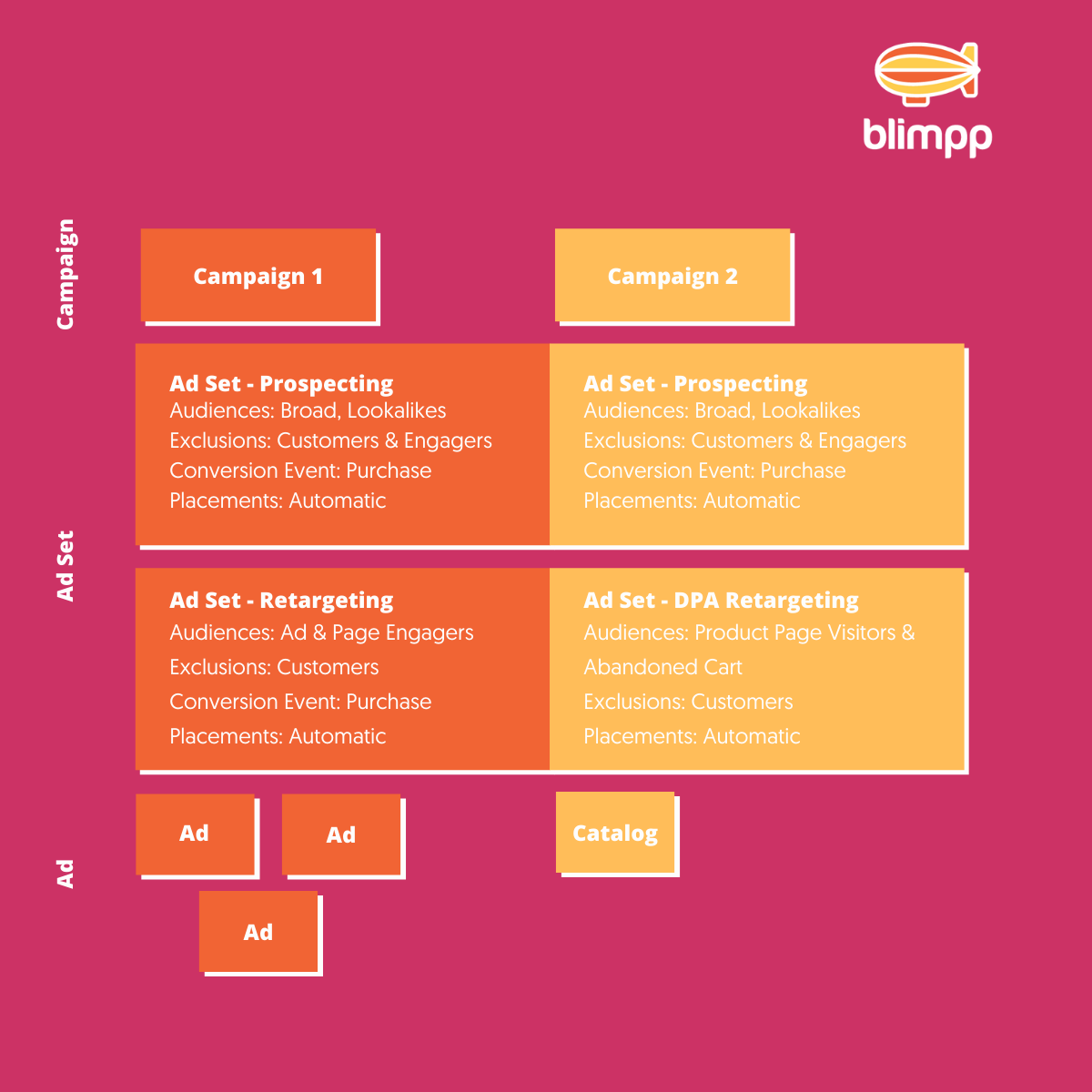
Step 3: Get your retargeting journey right
Retargeting is a crucial part of the customer acquisition process. Not only is this important for acquiring new customers, but also key to reactivating existing ones.
At the heart of it, Facebook retargeting success comes down to four core audience segments: website visitors, category page or product page visitors, cart or checkout abandoners, and recent customers.
For best results, we’d recommend automatically syncing your CRM audience segments to Facebook, as it allows you to always ensure that your segments are fresh and relevant. Manually uploading customer data is an alternative, but far from ideal if you’re dealing with thousands of customers across multiple audience segments.
If you’re using an email automation platform like Ometria or Klaviyo, this is pretty straightforward to set up. Within Klaviyo for example, head on over to the “Integrations” tab and connect your account with Facebook to automatically sync over your email segments over to Facebook.

Step 4: Connect with impactful creative
We’ve talked about targeting, but by far the most crucial part of the equation is your creative. If you’re not relevant with your ad creative, i.e. matching the user’s last interaction they had with you to the next ad that you show them, you’ll quickly lose them and suffer higher click-costs as a result.
Bear in mind the following when crafting your creative:
- Are you infusing user-generated content to reflect that people like them are benefiting from using your products?
- Do you acknowledge specific pain points that the user faces every day?
- Are you backing up your claims with social proof elements that resonate with the user (i.e. awards, press reviews, customer testimonials)?
- Is your offer relevant and attractive to the user?
Lipstick brand ColourPop delivers relevancy here by running an ad about duped colours to audiences that are interested in competitor products. They acknowledge a specific pain point (buying “kiss-proof” lipsticks at a reasonable price), and the engagement on the ad delivers a strong social proof signal to even the most skeptical consumer.
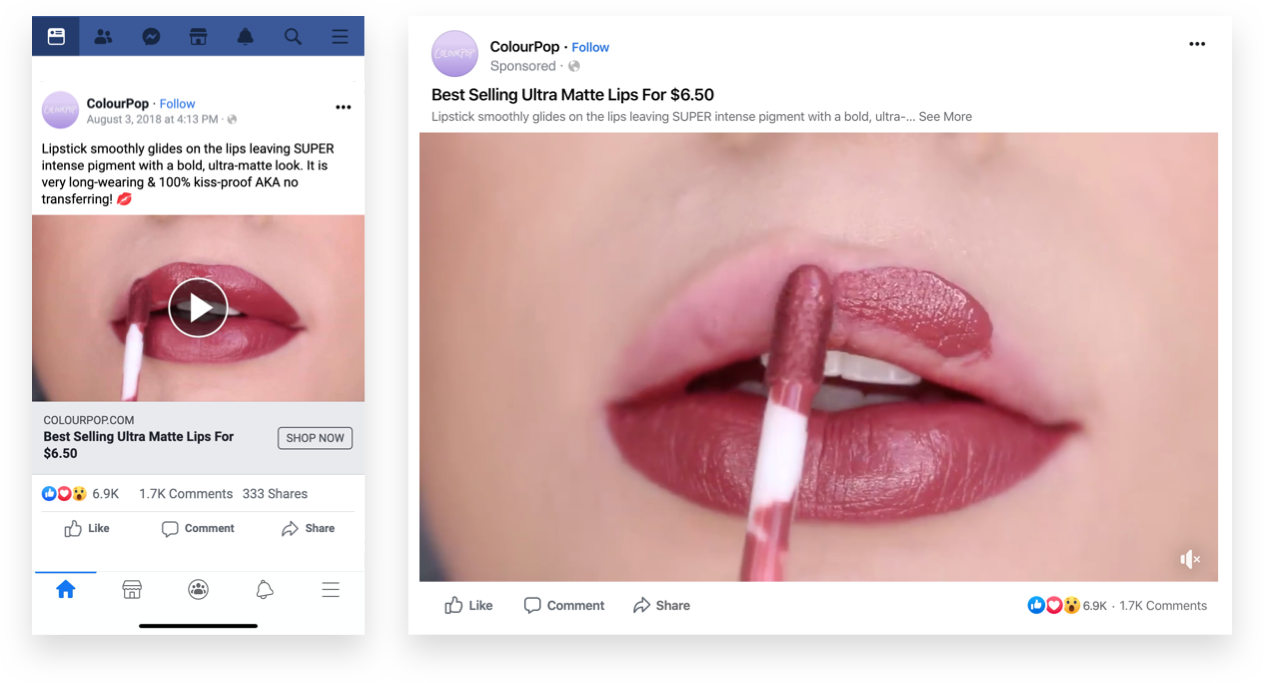
Another commonly used tactic is to leverage PR quotes to demonstrate industry “buzz”, as demonstrated here by personal care brand Love Wellness.
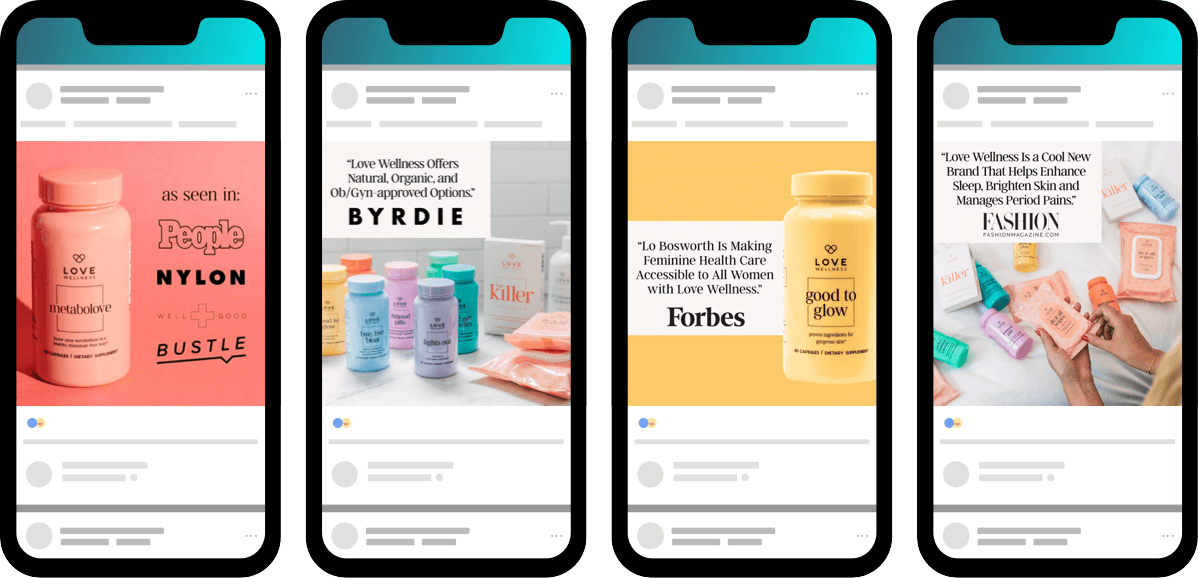
2. Influencer Marketing
Influencers are particularly useful when it comes to beauty and cosmetics marketing, as they have the ability to share results in real-time.
With influencers’ live social media tutorials, consumers can experience the assurance associated with a brick-and-mortar store, where they can try on samples before they commit to purchase.
Choosing which type of influencer to work with
One of the key things to initially think about with influencer marketing is, what kind of influencer will you work with to maximise returns?
There are two types of influencers, micro and macro-influencers. Micro-influencers are those with a following in the range of 1,000 and 100,000 fans and may be experts in one or two specific niches. On the other hand, macro-influencers are those with millions of followers, and who may have a broader set of followers.
While macro-influencers can be attractive with their larger following, micro-influencers have a higher potential when it comes to marketing beauty products. Consumers tend to listen to influencers who represent them demographically and face the same challenges as they do. That’s why a scrappy-looking YouTube video on how to conceal pigment spots featuring a person who actually has them, will likely be more relatable than a macro-influencer with seemingly “perfect skin” mentioning your product in passing.
An example of a brand that leverages micro-influencers well is Suave Beauty.
They worked with a number of African-American beauty influencers in a bid to reach a multicultural audience. With this campaign, they recorded an 11 point lift in brand recall and a 6 point lift in purchase intent.

According to Cody Wittick of Kynship, an influencer marketing agency, YouTube tutorial content that shows the results of a product, plus influencer testimonials such as “this product made me [benefit]” can be effective at achieving cut-through with a particular audience.
Finding influencers to work with
The first step in finding relevant influencers to work with is to consider all of the options. There are usually four main ways to find influencers:
- Analysing influencer followers (people that follow influencers)
- Analysing which influencers your followers follow
- Analysing who your competitors follow
- Influencer marketplaces
Influencer followers
You may find that influencers typically follow and engage with one another as a form of community, meaning you can find other influencers by seeing who the influencer is following and interacting with. Social platforms also do a great job of grouping similar influencers together, and you may see recommendations to follow certain influencers based on other people you follow.
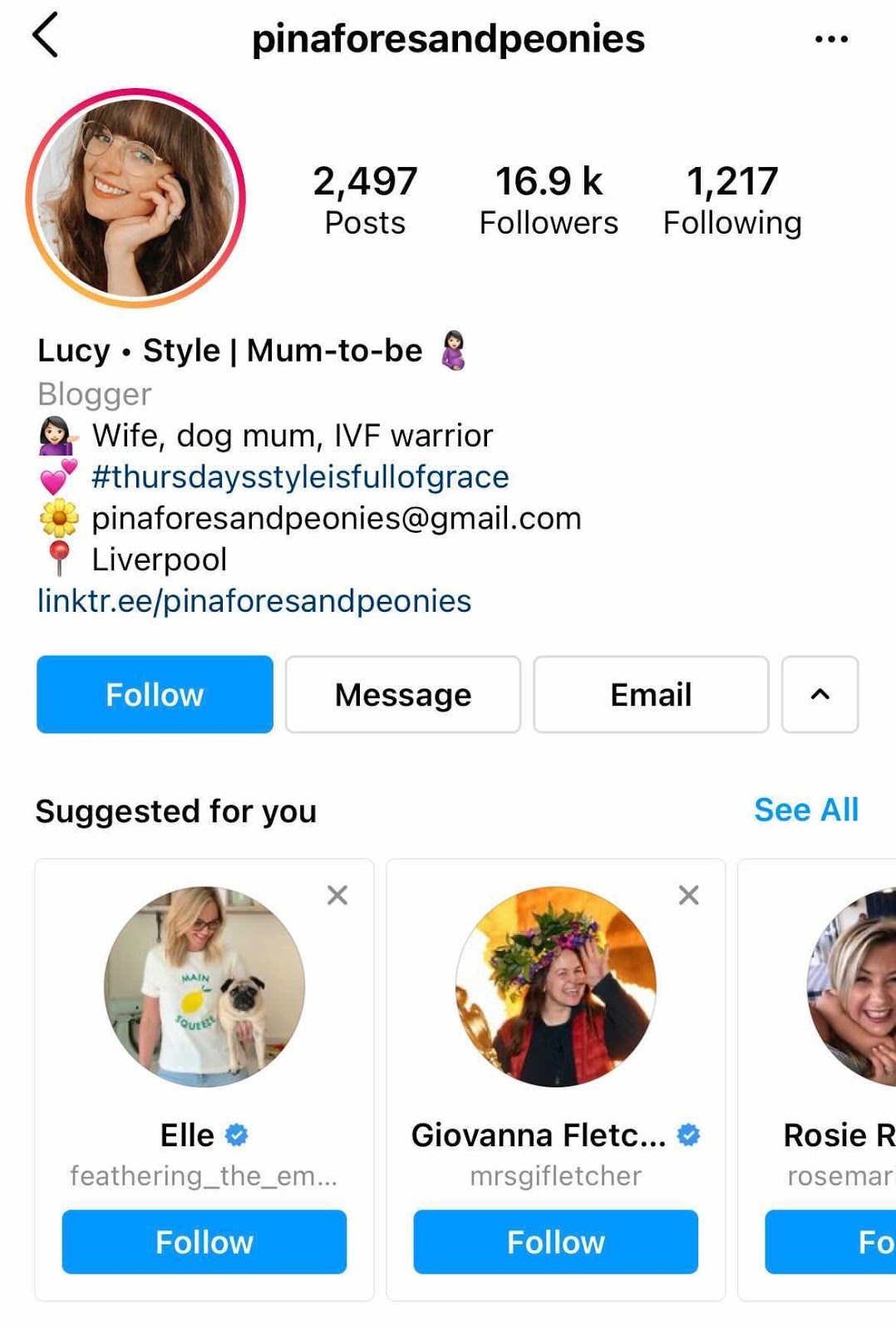
Influencers your followers follow
You can analyse the influencers that your followers follow in order to build an idea as to who is relevant in your space. If you see trends in that the same people are being followed by multiple followers, it’s usually an indication that the influencer is aligned to your target audience.
Analysing who your competitors follow
Analysing your competitors’ activity can yield multiple benefits, not least when it comes to influencer marketing. Take a look at who they follow to unearth insights around the types of influencers they engage with – then approach them to work with your brand. You can also take note of where competitor brands have been tagged across social media platforms in order to find influencer posts. Chances are if they’re relevant to your competitors’ audience, they’ll be relevant to yours too.
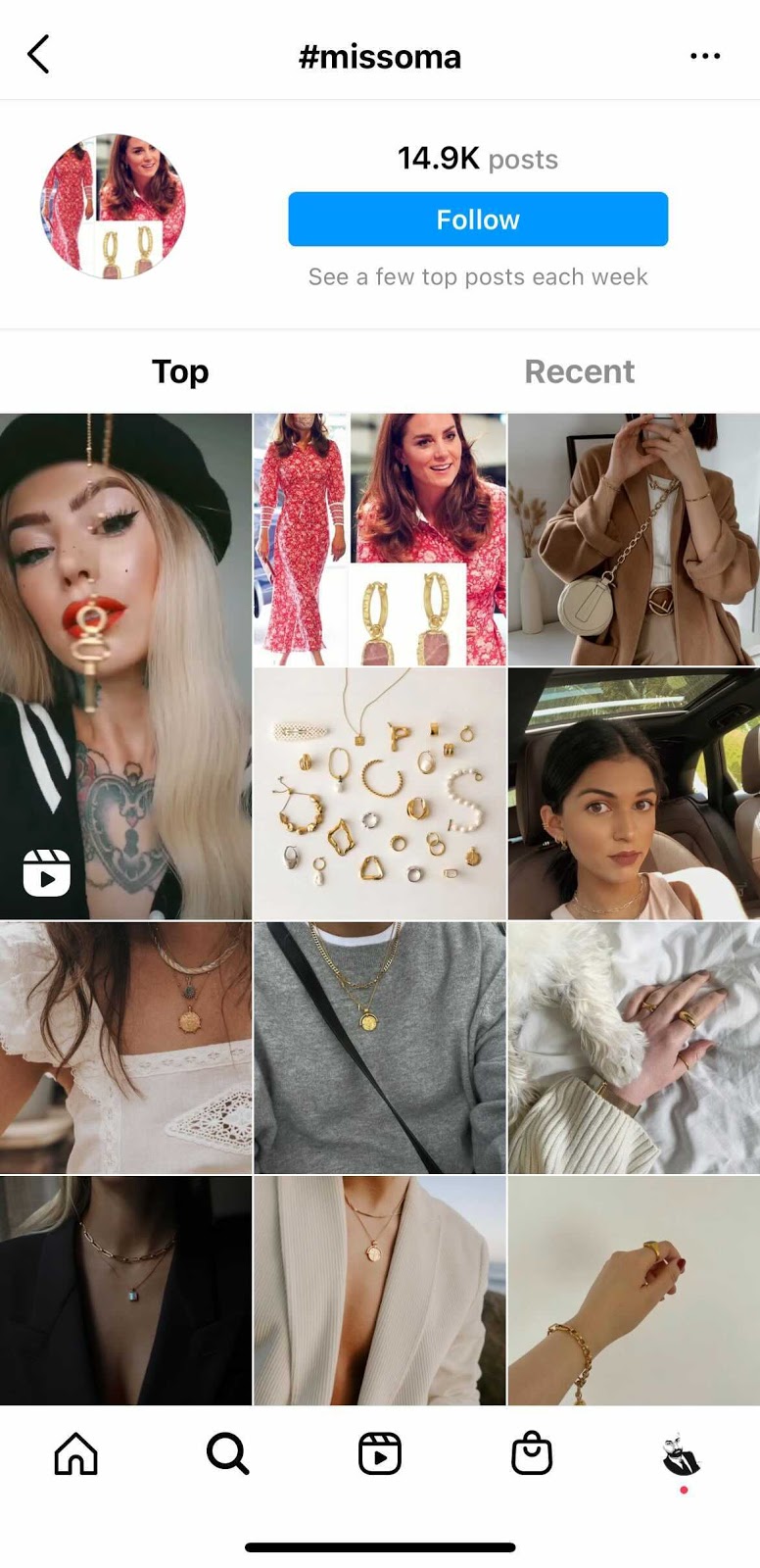
Influencer marketplaces
As influencer marketing has gained in popularity, a number of marketplaces have sprung up to help you source influencers. These include Shoutcart, Whala, Socialix and HashtagPaid to name a few.
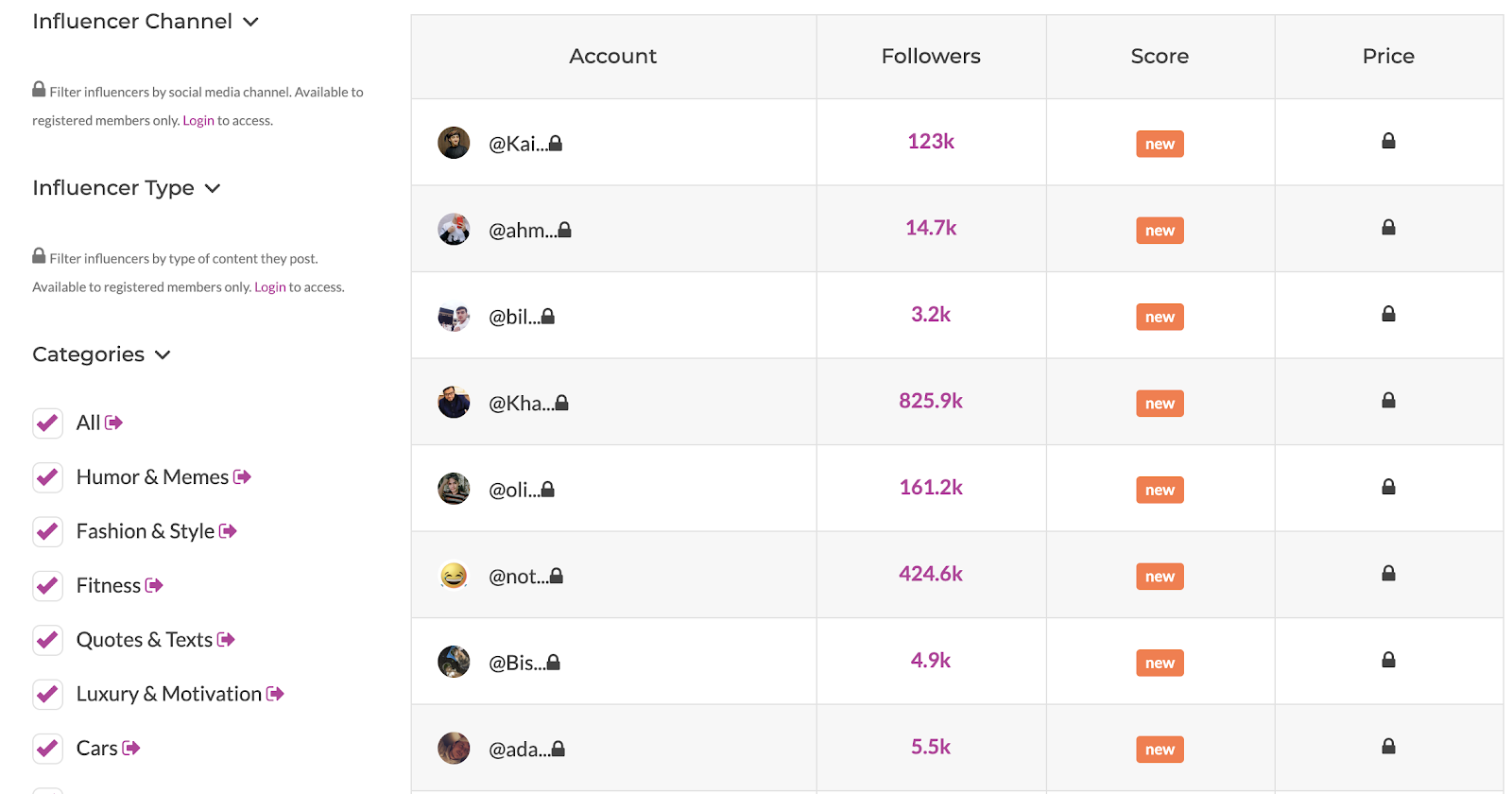
3. Search Engine Marketing
Search Engine Marketing always was, and will continue to be, one of the most important channels you can use for capturing high-intent demand.
Approximately, two-thirds of SEM clicks on Google go to Google Shopping ads, the image-focused product links at the top or side of text listings.
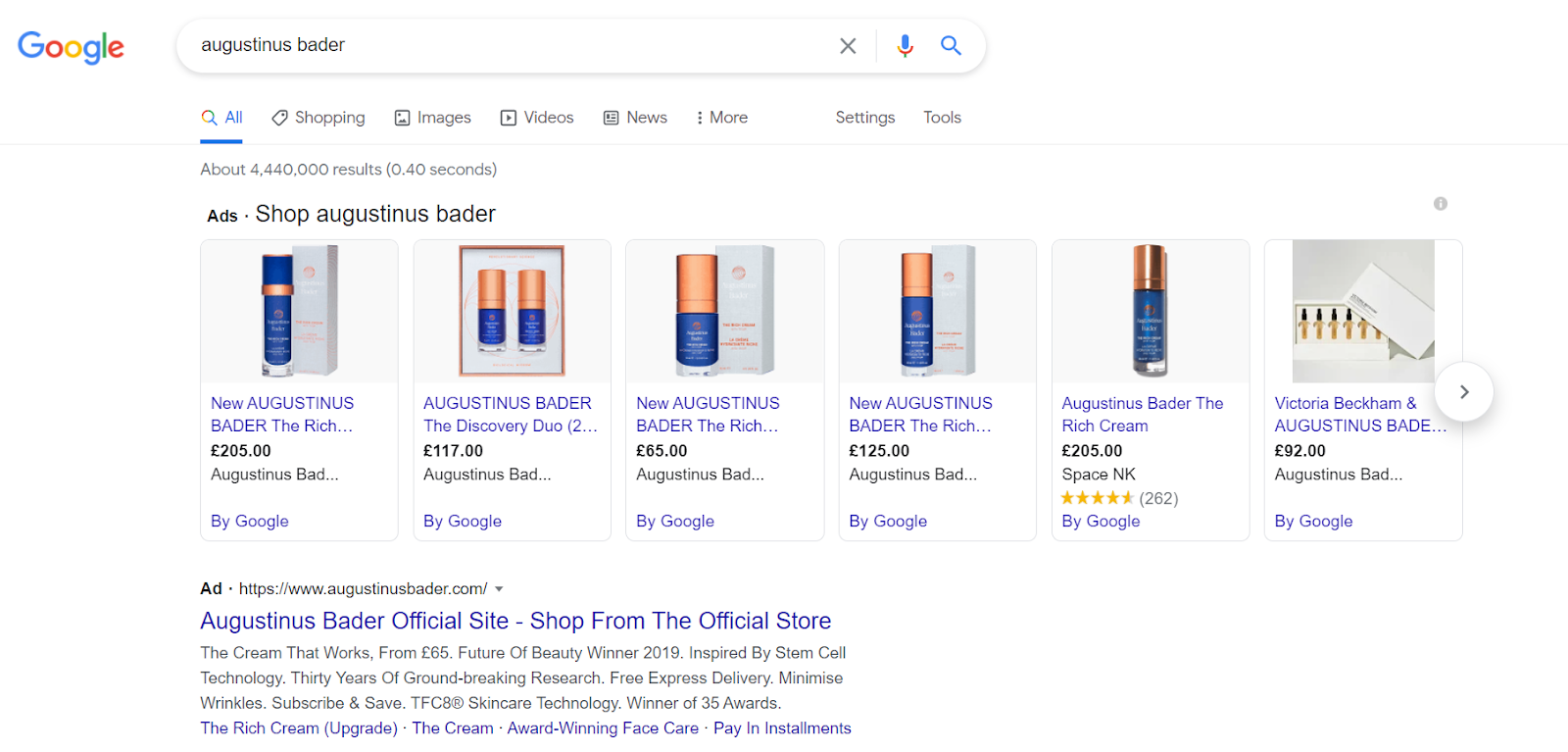
Within Google Shopping, there are three core elements that will determine the success of your campaigns:
- Data feed management
- Shopping campaign structure
- Bid management
Data feed management
Rock-solid data feed management is a central part of winning with Google Shopping. That’s because as opposed to standard search campaigns, Google Shopping campaigns don’t use keyword targeting to match ads against search queries. Instead, ads are targeted using the data in your product data feed which sits within Google Merchant Center. Ads are created on-the-fly using structured product data.
Google has a long list of specifications that explains which data they need and in which format they need it in.
While there’s plenty of data you can send directly to Google in feed format, not all fields are equal. Certain optimisations will have more of an impact than others, with product title perhaps being the most important.
As you only have a limited amount of characters to play with before text gets truncated, it’s important that you align product titles with how users are searching for specific products or product types. Examples may include:
- Brand + Product Type + Colour + Material
- Gender + Brand + Size + Product Type + Colour
- Material + Product Type + Colour + Brand
- Style + Colour + Product Type + Brand
Think about how you can get potential non-brand search keywords into your products. And take note of the order. Google places more weight on words at the beginning of the title than those towards the end.
Campaign structure
In general, we’d recommend setting up multiple Shopping campaigns, based on different Return on Ad Spend goals. At the top tier, focus on your best-performing products within a Smart Shopping campaign. This will ensure that your top-sellers receive the lion’s share of your overall budget.
In your secondary campaign, you’d want a lower budget for products that deliver middle-of-the-road Return on Ad Spend, perhaps due to lower AOV or Conversion Rate.
Bidding strategy
Google Smart Shopping employs smart bidding for it to determine how much to bid across each impression. Basically, this means looking at hundreds of data signals to determine how much each impression is worth – for example, if the user has been on your website previously, if they fit into a relevant “in-market” Google audience segment, and the device that they are using.
Setting a Return on Ad Spend goal that’s not realistic based on historical data trends can result in poor campaign performance, so it’s important to ensure that the goal that you apply is realistic. Our best practice here is to aim between 120% and 140% of your historical average.
It’s also important to allow the bid strategy at least 15 days to run before you make further changes, as it kick-starts a ‘learning phase’. If, after a period, you make significant changes to your campaign, like restructuring your product groups or changing the target products, give the bid strategy time to adjust. Learn more about Target ROAS bidding for Smart Shopping campaigns here.
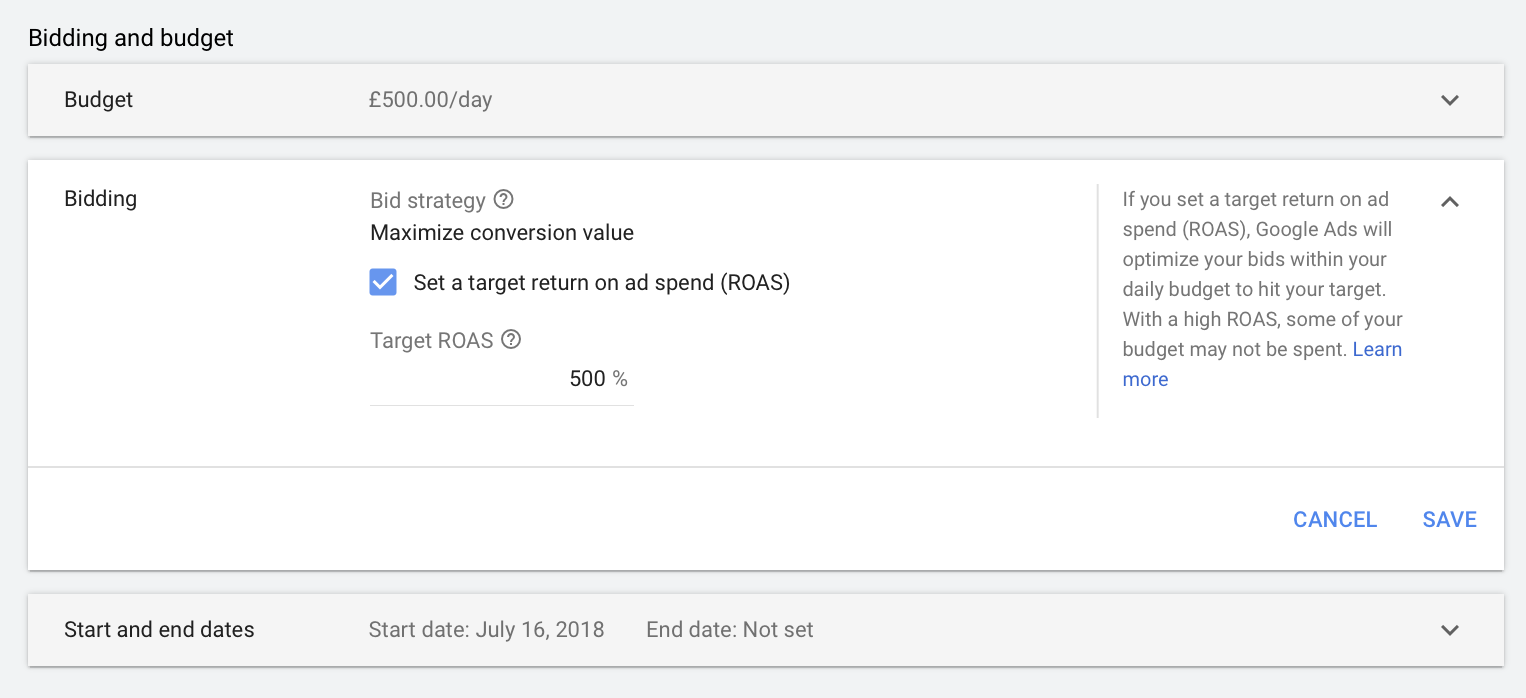
2. Beauty eCommerce Marketing: Driving Conversion Rate By Optimising Your On-Site Experience
As long as you’re driving the right type of traffic, you’re one step closer to achieving your acquisition goals. Next up, we look at how best to maximise that value of the traffic coming through by optimising on-site conversion.
How you approach this is crucial to your bottom line because when visitors arrive on your website for the first time, you have only a few seconds to leave an impression that they’re in the right place, and convince them to take a valuable action – such as signing up to your email list, viewing a product, or ultimately, making a purchase.
When looking at how to optimise the on-site experience, there are a few specific levers we can pull:
- Improve speed and usability
- Provide relevant product recommendations
- Improve on-site search
- Improve cart abandonment efficiency
4. Improve Speed & Usability, Especially On Mobile
A slow loading site can kill your conversion rates and lead to inflated customer acquisition costs. According to Skilled, 64% of smartphone users expect a website to load in 4 seconds or less, with 47% of online shoppers expect pages to load within 2 seconds.
Google’s mobile page speed study also found that a site’s bounce rate increases for every extra second it takes a page to load.
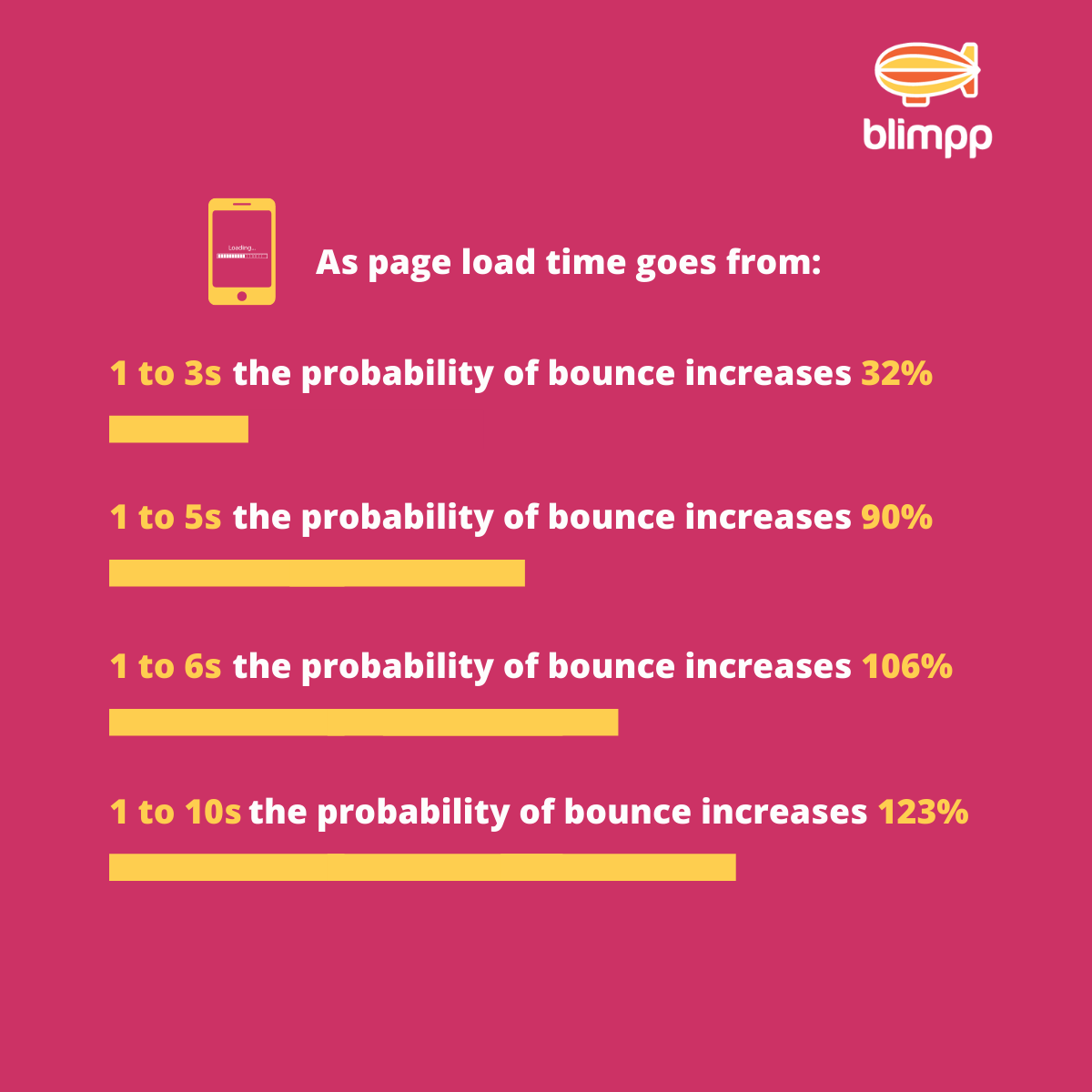
Site and page speed also impact both paid and organic rankings and is also a factor in how Google Ads prices your clicks. Expect lower organic rankings if your page is slower than average to load, and also to pay more per click than those advertisers that have faster-loading pages.
Identifying issues with site speed
There are a wide variety of tools available that can test and grade your site speed performance, including:
These tools work by looking at several elements of a website, including CSS, Javascript, images, and caching.
PageSpeed Insights is particularly good for looking at page speed by device, and to compare your own site performance with those of your competitors.
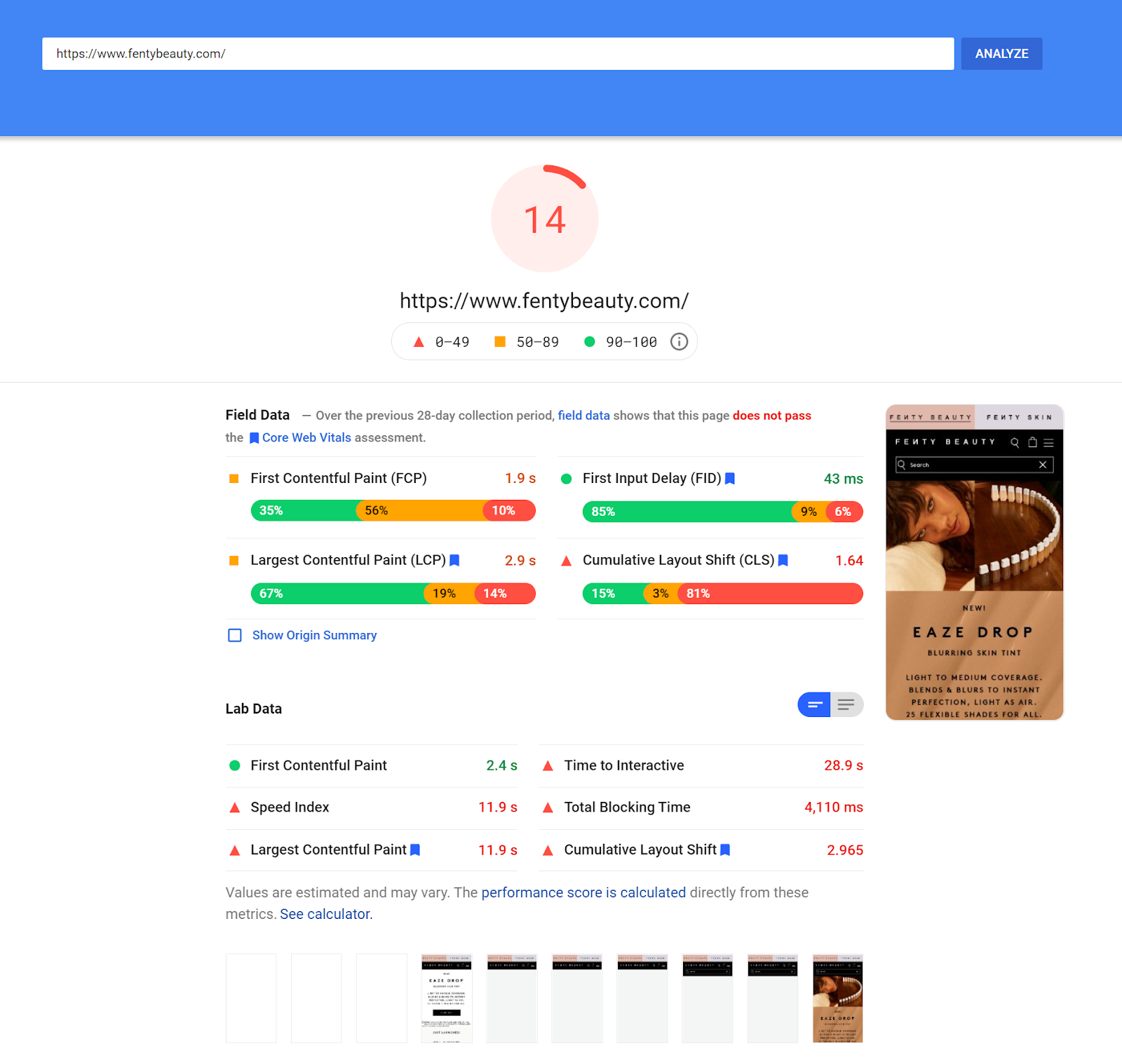
GTmetrix gives your website speed a grade from A to F. It merges data from several sources and offers a performance report to help you analyse issues that require optimisation.
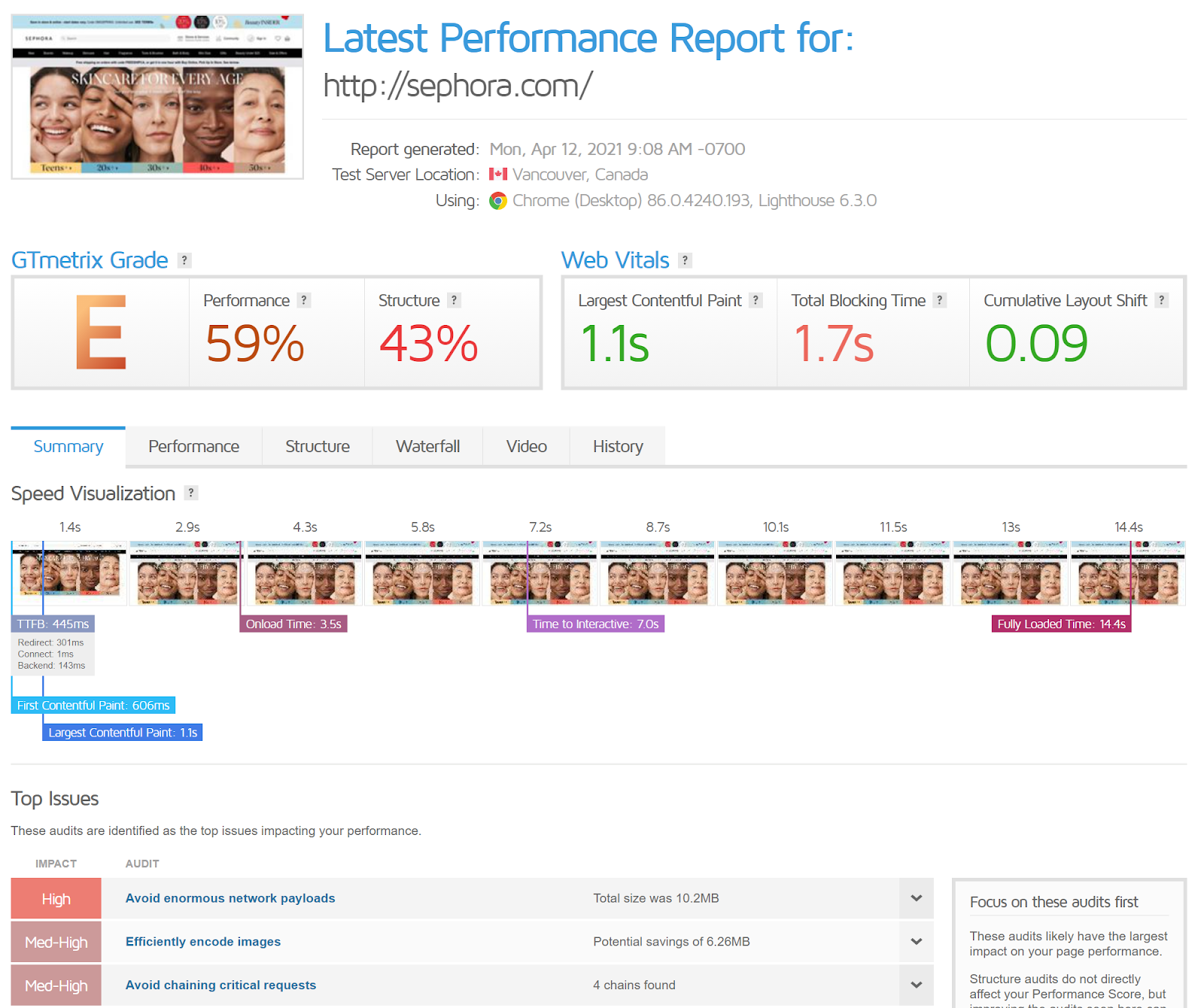
Note that website speed tools use different criteria to gauge your speed and therefore the results should typically be viewed more as general guidelines.
Fixing site speed issues
Once you’ve identified bottlenecks, there are a number of ways that you can look to fix them. According to Shopify:
- Look for a fast ecommerce platform – out of the box
- Use fast and reliable hosting
- Use a content delivery network (CDN)
- Organize your tracking with Google Tag Manager
- Prioritize testing and optimizing your mobile performance
- Use pop-ups sparingly
- Beware of excessive liquid loops
- Decrease thumbnail image sizes
- Ease up on homepage hero slides
- Weigh the benefits of installing another app for your site
- Compress and reduce images in size and number
- “Minify” your code
- Reduce redirects and remove broken links
For more than two decades, Osmotics Cosmeceuticals has been a leading provider of cosmeceutical treatments for skin and hair. The company made the decision to prioritise site speed in order to optimise sales across channels. Within two months, Osmotics Cosmeceuticals saw a 46% jump in mobile traffic and more than 23% of sales originating from mobile devices, compared to less than 5% during the previous period.
5. Product Recommendations
When you walk into a brick-and-mortar store and find a salesperson ready to help you find the right products to suit your needs, it makes the whole purchase experience easier and more enjoyable.
Unfortunately for Direct-to-Consumer eCommerce brands, virtual salespeople have yet to catch on, and customers are plagued with the paradox of choice overload, which often leads to site abandonment.
So how do we bridge the gap between choice and consumer experience?
One way is through product recommendation quizzes.
Quizzes can be a fun, engaging way to bring people closer to your brand, and really personalise their overall customer experience with you.
They can be particularly effective at warming up cold traffic (i.e. first-time website visitors) and kick-off the process of product discovery, in a way that a conventional user journey may not. For example, many first-time visitors, particularly those who have discovered your brand through an ad on Facebook or Google, may navigate to a category page, browse a couple of products, and then leave without taking further action. With a quiz, you can focus their user journey by better understanding their needs and preferences, and then recommend specific products based on their answers.
Another benefit of shop quizzes is that you can group together people based on their responses, and tailor their subsequent on-site experience so that it’s most relevant to them. In doing so, you’ll likely see an uplift in Conversion Rate.
To make this happen, you’ll need to segment quiz respondents into specific groups, based on their responses – specifically, their feelings, attitudes, beliefs, needs and preferences.
Skincare brand BeautyBio demonstrates how to build a quiz with customer segmentation in mind, focusing questions around user skin types, skincare concerns, and attitude to skincare in general.
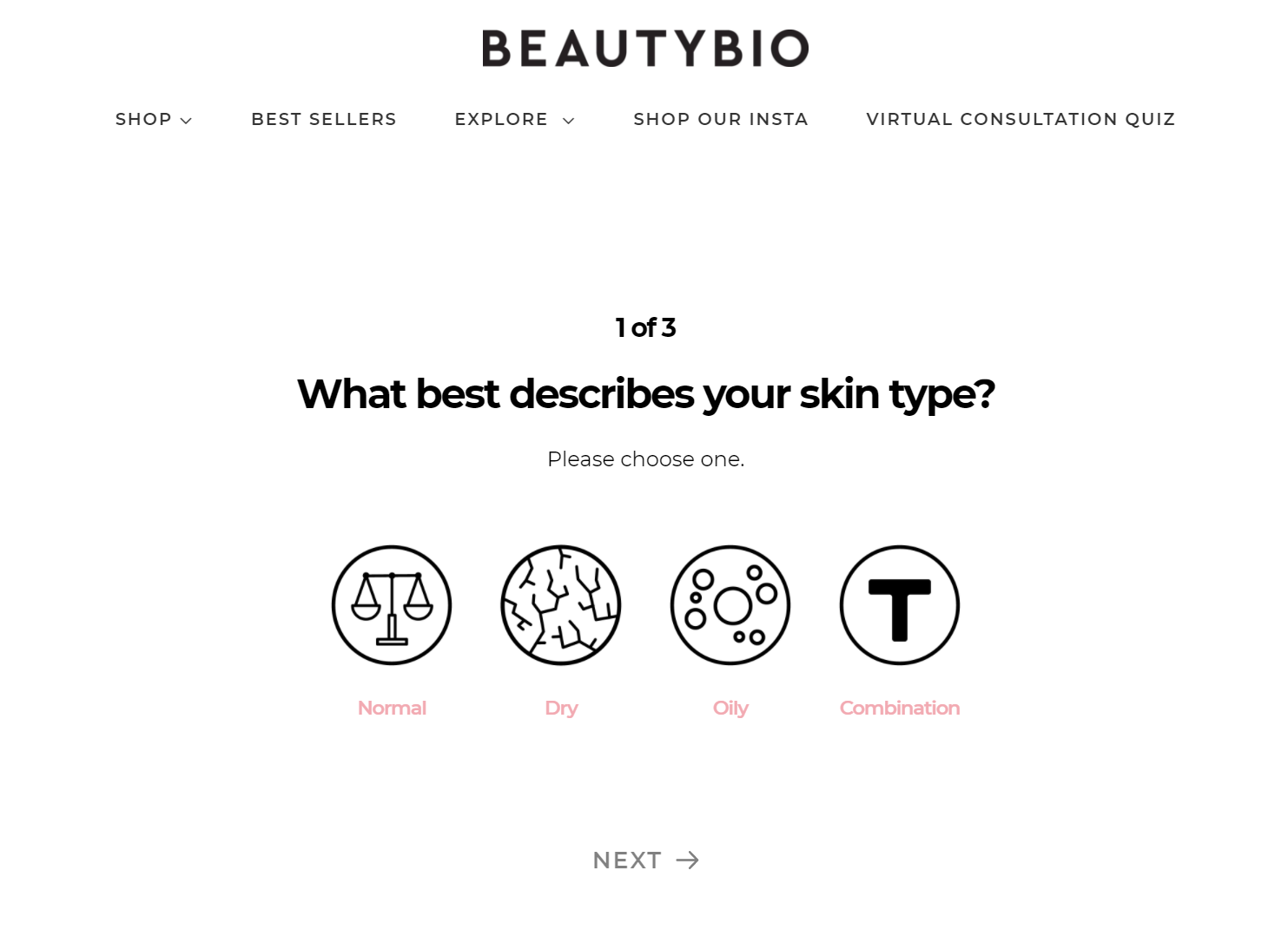
As people take the quiz, BeautyBio can collect data from each question, product recommendation results pages, and individual users that opt-in to receive further marketing communications. They can then use this data to power campaigns across email, SMS, and paid advertising platforms like Facebook and Google.
When creating quizzes, it may be a useful starting point to focus on questions that will make the process of customer segmentation more straightforward. For example, think about how each question will enable not only more robust personalised recommendations, but also more tailored messaging across email and retargeting campaigns.
Once you have an idea of what specific needs your quiz respondents have, you may want to re-focus your messaging to better suit relevant pain points. This will involve looking at content on-site and across your digital touchpoints.
For example, BeautyBio could create specific segments around respondents to the question “What’s your main skincare concern?” in order to deliver tailored retargeting messaging to each segment. In this scenario, it could create segments based on:
- Respondents who are concerned about breakouts
- Respondents who are concerned about fine lines and wrinkles
- Respondents who are concerned about uneven skin tone
- Respondents who are concerned about their skin’s overall appearance
By doing so, it can increase the relevancy of its messaging, such as in the case below – a Facebook ad that’s focused around those within the “concerned by skin tone” segment.
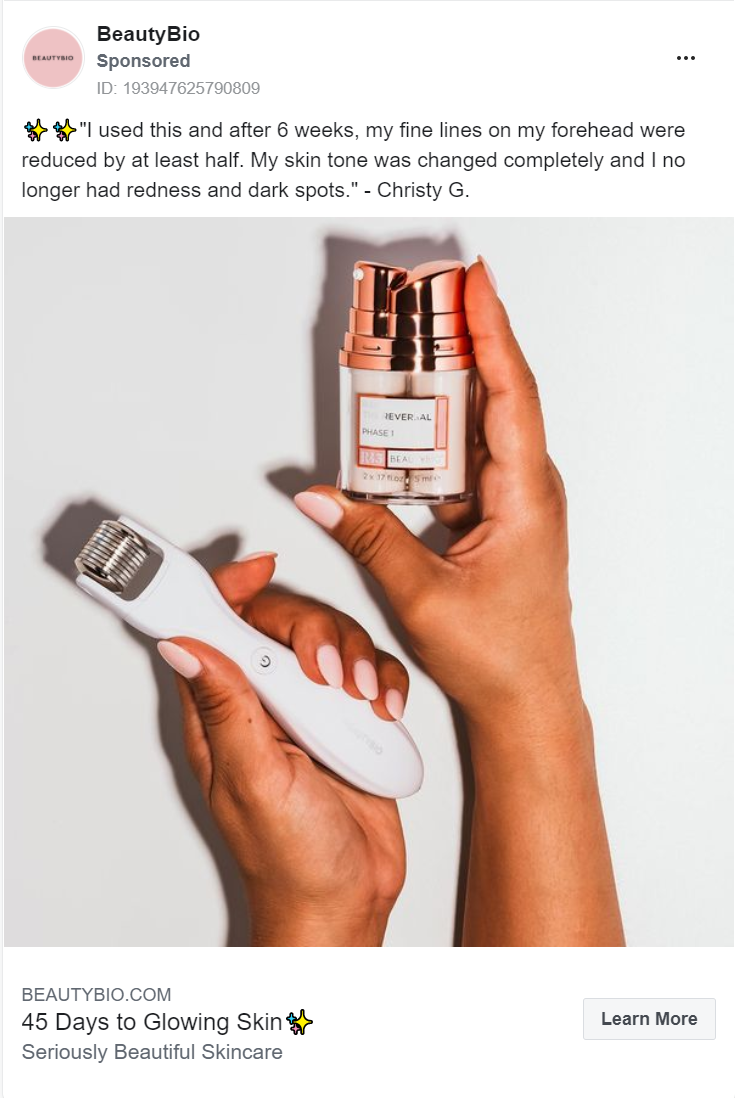
Using quiz responses to shape your segmentation strategy is an effective way to personalise messaging. Rather than sending out blanket email and SMS communications to your database, instead look at ways you can achieve greater cut-through by better suiting individual needs and preferences. Create a quiz funnel that facilitates that, delivering recommendations on specific pain points.
6. Improve On-site Search: Product Filtering
While less than 10% of users perform searches, these searchers can account for up to 40% of site revenue, according to a study by ConversionXL. Still, many e-commerce websites fail to devote resources to optimizing their on-site search experience.
Adjusting your store’s browsing, discovery, and checkout experience is just as crucial as a brick-and-mortar store optimising its shopping layout. Do you remember walking into a store, and asking a salesperson for the exact location of a product that you’re looking for?
Within eCommerce, focusing on your on-site search and product filtering are two key ways that you can deliver a frictionless buying experience.
Your on-site search function can serve as a powerful tool to guide your customers. Some brands include a demographic filter and dynamically suggest products as customers type in their search queries.
A good example to imitate when it comes to a comprehensive on-site discovery experience in beauty eCommerce is SKINCEUTICALS. First, they execute a well-thought-out product discovery mechanism, which although similar to a quiz, takes a slightly different form from “conventional” quiz-based product recommendation tools.
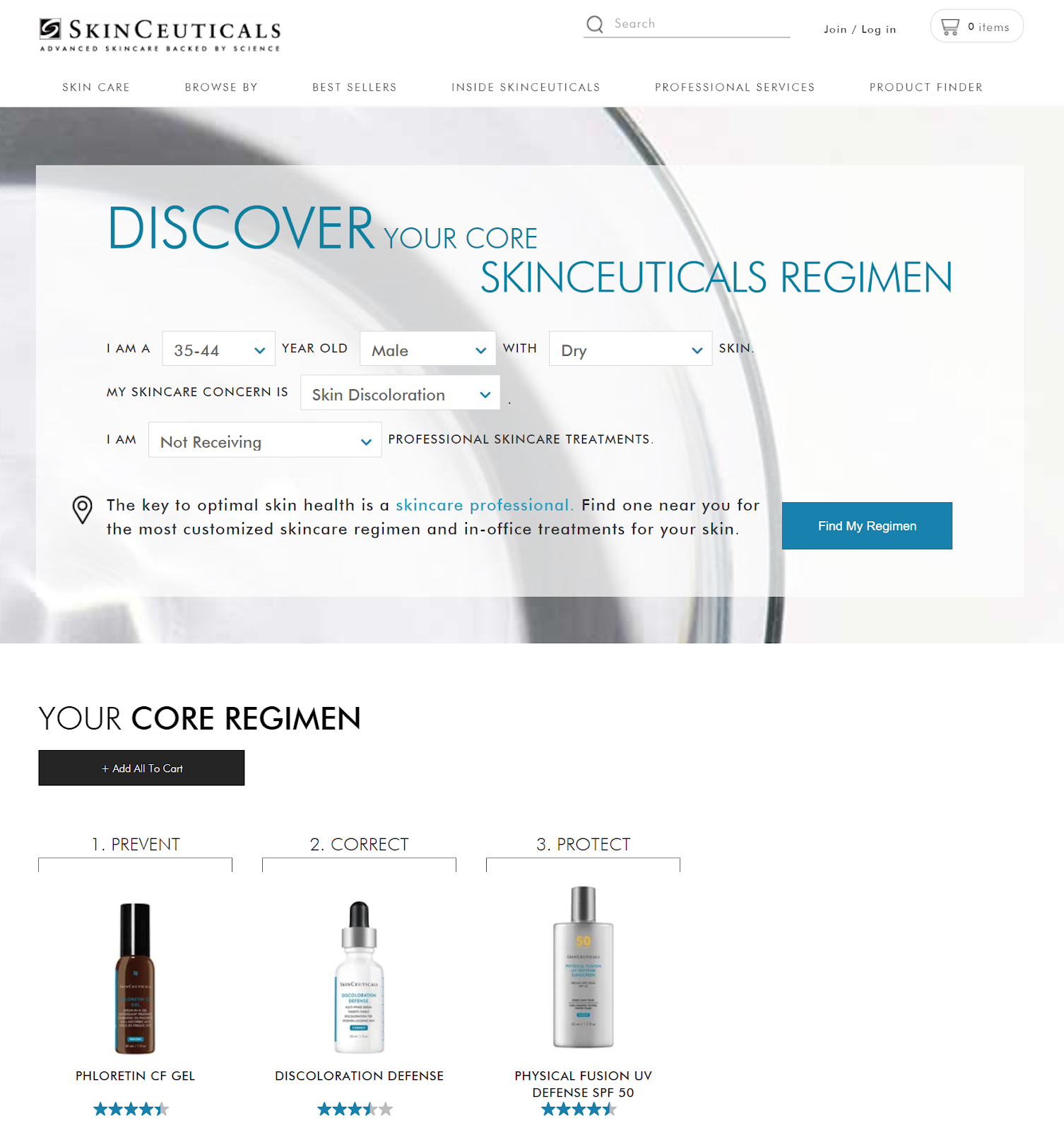
Second, the on-site search function provides real-time results, which automatically display relevant products based on user inputs. This can also help to improve Average Order Value, in that the brand can display higher value product recommendations first.

Finally, the website also lets you compare different products in an intuitive, well-structured way. Given that they offer 67 products to combat dry skin alone, this is a conversion-boosting tool that cuts down the noise around each product to its bare features – such as price, ingredients, benefits and core function.
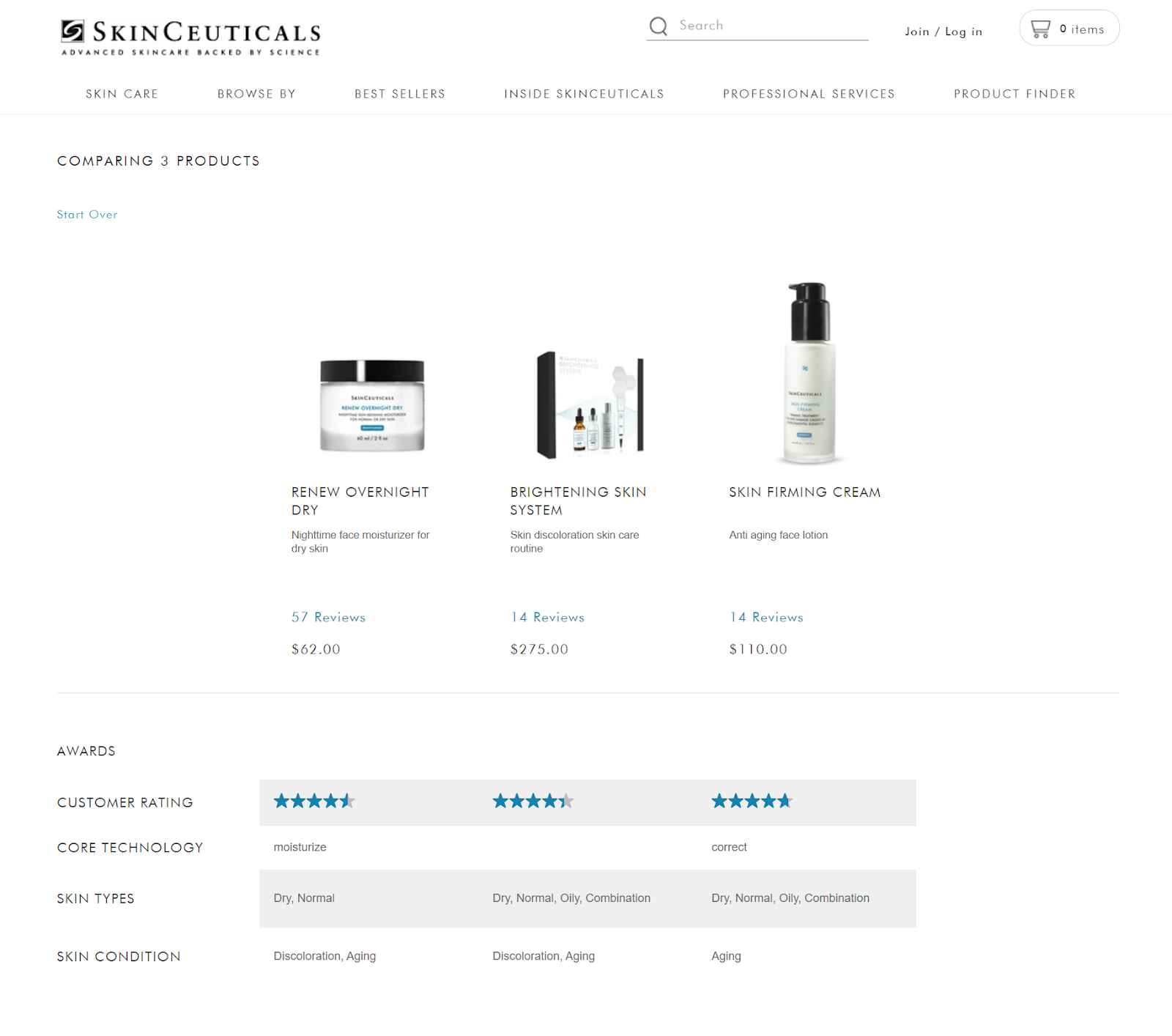
Improving your site’s overall search experience can be a highly effective Conversion Rate Optimisation technique. Moreover, optimising the on-site search experience can help you to better understand what your customers are looking for, allowing you to make better product merchandising decisions.
So it makes perfect sense that one of the most important elements of managing a Direct-to-Consumer beauty eCommerce store is to ensure a clear, well-structured on-site search experience that helps the user to find exactly what they’re looking for.
7. Improve Cart Abandonment
Cart abandonment within eCommerce is on the rise. In 2019, almost 70% of eCommerce shoppers abandoned their purchases before checkout. In early 2020, the abandoned cart rate shot up to nearly 95% as locked-down consumers increasingly turned online for their shopping.
According to Statistica, the top reason why U.S. customers abandon their online shopping carts is “unexpected shipping costs at checkout”.
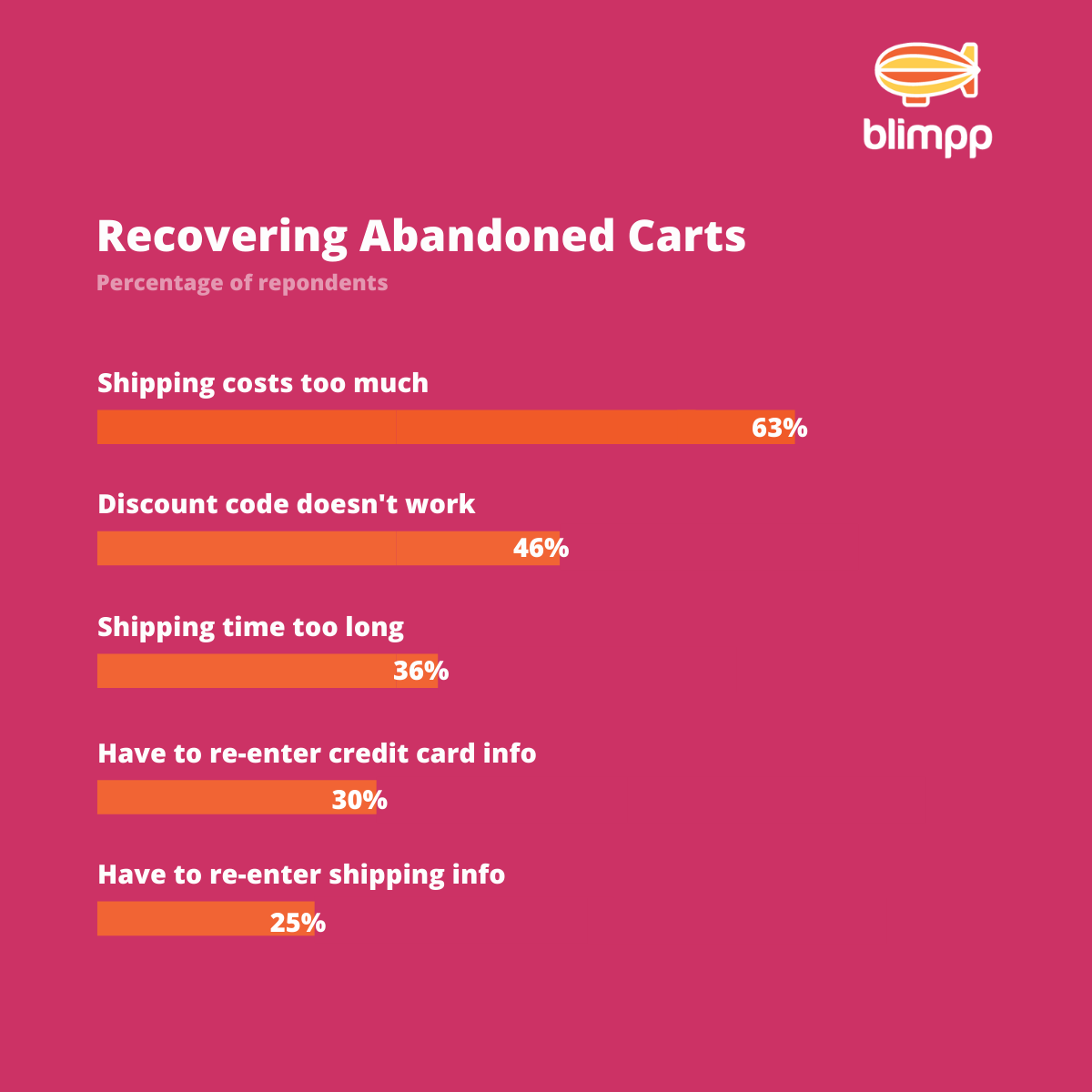
From a customer experience perspective, this makes sense. The customer has added the product to cart and reached checkout before discovering they need to pay extra for shipping. At this point, they need to make another purchase decision. Creating friction like this inevitably leads to customers second-guessing their decision and not checking out at all.
Other people have beauty-specific concerns: what if their skin tone isn’t a match and they don’t figure it out until they’ve opened the product? What if the product isn’t right for their skin type? Here’s where a robust returns policy can help to reduce buyer friction. Strategically-placed guarantees within the checkout flow can help to communicate that no matter what, the risks of buying from you are low.
For Direct-to-Consumer beauty brands, the use of cart abandonment follow-up campaigns can help swerve cart abandonment trends the other way. According to research, abandoned cart emails have an impressive Conversion Rate of 4.64%, compared to 0.17% of newsletters. We cover this type of email in more depth, within the next section.
3. Beauty eCommerce Marketing: Driving Customer Lifetime Value Through Email Marketing & SMS
Customer lifetime value (LTV) is one of the most important metrics you need to be tracking – and improving – to scale your brand over time. Unfortunately, it is also one of the most overlooked within eCommerce.
Before you start trying to figure out the net profit of each customer over the lifetime of their relationship with you, know that taking that route may be impractical. Instead, determining what each customer is worth over a specific payback period is perhaps a more straightforward and less caveated approach. Let’s look at how you can do that.
8. How to Calculate Customer Lifetime Value
To calculate your LTV, you need to multiply your Average Order Value by your average purchase frequency rate to determine your customer value. Then multiply that value by your average customer lifespan, in this case, your calculated specific payback period.
Mathematically, LTV = Average Order Value x Average Purchase Frequency Rate x Average Customer Lifespan.
Let’s break this down further.
Average Order Value: To get this value, divide your total revenue over a time period, say one year, by your total number of orders in that same period.
Average Purchase Frequency: To get this value, divide your total number of purchases over a time period by the number of unique customers who made purchases in that time period.
Average Customer Lifespan: get this value by averaging the time period a customer continues purchasing from your brand.

How to determine your Average Customer Lifespan
There is no one size fits all rule for determining your average customer lifespan. This is relative to your business and your sales cycle. With historical data that allows you to view the average time period between customer purchases and overall customer behaviour, you should know what time period should be allocated to your lifetime value calculations.
However, for new businesses, with no historical data to turn to, there’s an acceptable ballpark of one to three years, with most marketers regarding anything beyond seven years as being too far in the future.
For example, you have an Average Order Value of $150 and an Average Purchase Frequency of twice every year. On top of that, you’ve analysed your customer behaviour data and found your average customer lifespan to be three years. Inserting all these values into the formula above would give you a LTV of $900.
Now that you know how to calculate your LTV, next up is improving it. To scale your business, your LTV must improve over time. While there are different ways to increase revenue, customer retention can play a key role in increasing your LTV.
Therefore the main question now is how do you increase customer retention? Let’s look at some key levers that can help you answer this question:
- Email Marketing: Automated flows
- SMS: Use SMS to re-engage with existing customers
Email is still a very useful form of communication and a really effective tool when it comes to upselling your current customers and nurturing relationships over time. According to a DMA National Client Email Report, on average, every $1 spent on email marketing generates an average return of $38.
How many times have you checked your email in the past 24 hours? 5, 10, or 20?
Your customers are people like you and are doing the same. What this means is that if you aren’t already leveraging email marketing to extend customer lifespan, you’re missing out on revenue. Let’s look at how you take advantage of automated flows within email.
9. Email Marketing: Automated Flows
Automated flows are predefined email series that get triggered by some event or after an elapsed period of time.
For example, when a potential customer signs up for your newsletter, you’d want to engage them within an onboarding – or welcome – sequence of typically between 3 and 5 emails, all sent within the first 10 days or so. However, doing this manually every time you get a new subscriber is not feasible, especially if you get hundreds or thousands each day.
That’s where automated flows come in. Automated flows have a wide range of use cases that goes beyond welcome emails. For example, you can personalise different setups based on customer behaviour data.
For example:
- Welcome emails
- Abandoned cart emails
- Browse abandonment
- Post-purchase emails
- Customer re-engagement
Of the various email flows, the two that are perhaps most relevant to customer retention are post-purchase and customer re-engagement (also known as customer winback). But let’s go through all of the options and see where we might utilise each to drive both initial and repeat purchase.
Welcome emails
Most beauty eCommerce brands use some form of welcome or onboarding sequence to drive familiarity and initial engagement. Depending on what your customers sign up for, your welcome emails can include your brand story, an idea of what to expect from future emails, and a formal introduction to some of your best-sellers. Let’s face it, the ultimate goal associated with sending a welcome email is to encourage that all-important first purchase.
Some brands include an incentive, such as a discount or free gift on first purchases. How you approach this depends on what suits your brand. For example, ColourPop offers a one-off discount within the first email, when open rates are likely to be highest.

Typically, you might expect an open rate of between 40%-50% for your first email (higher if you’ve promised a discount code in return for signup), so it’s important to be testing subject lines and content.
Commonly used subject lines for a welcome sequence include:
- Here’s your {discount} from {brand} (instant gratification)
- Thanks for signing up (remind the prospective customer that they signed up)
- Welcome {name} (short and sweet)
- You’re in! (make them feel like they’re part of something exclusive)
Note that your welcome emails should include a singular, clear call-to-action to encourage your new subscribers to take the action you want them to take. For example, emails 1 and 2 may focus on a “Shop Now” message, email 3 might focus on your brand story (leading to your “about” or “mission” page, and email 4 may focus on getting them to engage across your social channels. Whether it’s following your Instagram page or placing an order for lipstick, you’ll need to clearly signpost how subscribers can do just that, and more importantly, why.
Abandoned cart email automation flow
Most abandoned carts are a result of unexpected costs, such as shipping or taxes. Fortunately, with a perfectly timed automated email, you can introduce an additional touchpoint which may change your customers’ mind. By setting up abandoned cart email flows you can create personalised email series that reminds the customer of the product they left behind, in a supportive tone.
There are different ways you can approach abandoned cart emails. Some of which include offering incentives, and educational content, like showing them how they can use the products in their cart.
Note that while offering incentives like discounts or coupon codes can bring back customers, you don’t want to create an impression that customers can get discounts by abandoning carts. A lot of brands do this, and it partially explains why cart abandonment is higher.
One brand that unlocks the power of abandoned cart automation flows is makeup brand Too Faced. They dynamically incorporate products that were left in the cart and offer an aggressive 20% off discount to help facilitate the first purchase.

Abandonment flows all require people to be on your list in order to retarget them after they abandon a particular action. The main abandonment flows are:
- Browse abandonment (viewed specific products on your site, but took no further action)
- Cart abandonment (added products to the cart, but did no purchase)
- Checkout abandonment (started the checkout process, but didn’t finish)
With the three main types in mind, it makes sense to offer an aggressive discount if they’ve added multiple items to cart, or if they’ve abandoned the checkout process. In other circumstances, you might be better off sending a reminder email, signposting how they can resume their purchase journeys.
Order confirmation & post purchase email flows
The best way to boost customer retention is by building trust. You don’t want your customers experiencing anxiety after placing an order, and that’s where your confirmation email comes in.
Earlier, we mentioned welcome emails as a standard in the eCommerce industry, and confirmation emails and shipping notifications are other examples of automated flows that have become a standard.
Let your customers know that you are with them all the way, from when they order to when their products reach their doorstep.
Cult Beauty tick all the right boxes within their confirmation email.

Your post-purchase flow represents a chance to strengthen the relationship between you and your customers.
The overall objective of your post-purchase emails is to inform when customers can expect to get their products, but also to take valuable actions, such as to buy complementary products, leave a review, or complete a survey.
Again, a 3 to 5 step sequence here can help to extend customer lifetime value, so don’t miss this opportunity to re-engage when it matters most.
Customer re-engagement flows
A winback (or reactivation) flow is a series of emails sent to customers that previously engaged with you, but who haven’t engaged with you for a while.
Shopify may also label these customers “At-Risk” based on previous purchase habits.
As the name suggests, the objective here is to persuade this segment to purchase again, so to extend their LTV.
Rather than try to re-engage customers with a generic discount, beauty subscription brand Birchbox offer a free product into the mix, which is likely to resonate well with make-up aficionados. Going down this road, they demonstrate they understand their audience better than most, and offer something tangible the customer can touch and feel.
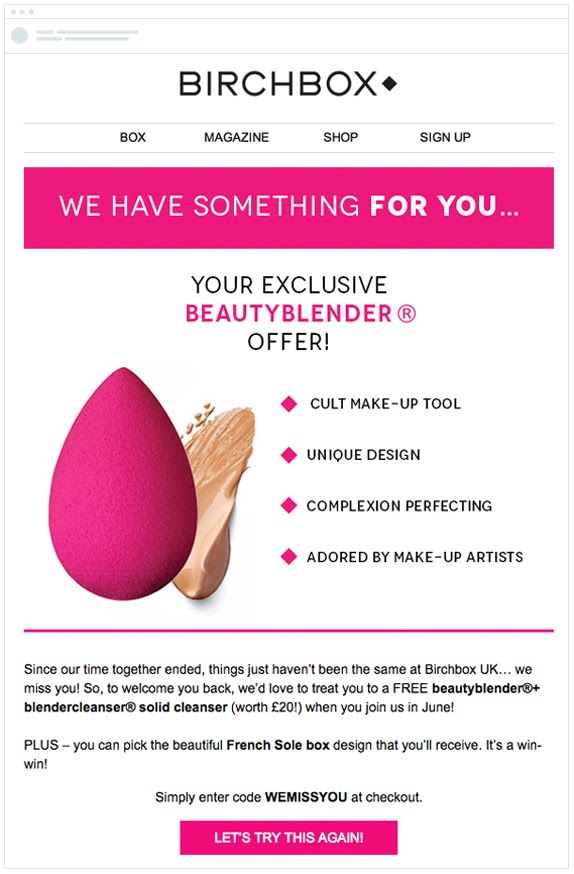
Feedback emails, like the one below from Anthropologie, can be a useful way of re-engaging with lapsed customers – to either reactivate them or to simply get their feedback so to better understand the reasons why they haven’t purchased in a while. This can help to refine all areas of your customer journey, from your on-site experience to the emails you send, and customer service. Anthropologie recognise that people are more likely to take the time to fill out a feedback survey if offered an incentive, in this case, a 20% off discount code.
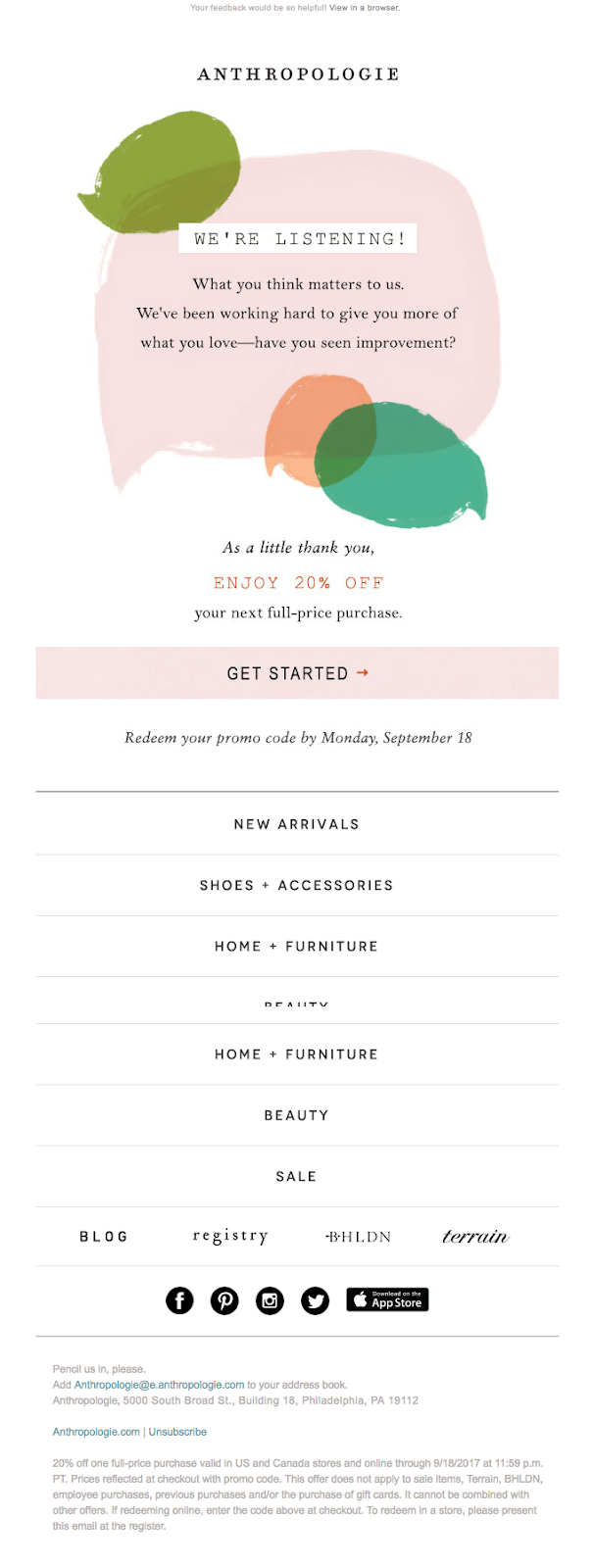
Choose the right email marketing platform
With a number of email marketing platforms out there, making the right choice can be overwhelming. However, there are some key points you should look for when doing your research:
Your email marketing platform should be able to:
- Send automatic welcome emails when someone subscribes to your newsletter or creates an account on your site
- Allow for a behavioural trigger, like abandoning a cart or browsing a certain product category
- Engage your customer post-purchase with order confirmations and shipping notifications
- Send automatic timed responses based on birthdays to nurture your customer relationship
- Create timed-based triggers to re-engage customers who are inactive
Here are a few tools you can consider if you’re new to email marketing.
Klaviyo
Klaviyo is a powerful, highly scalable, email automation tool that integrates with Shopify to deliver email experiences, unlike any other platform. Whether you’re just getting started with email, or have a database of tens of thousands, Klaviyo provides unbeatable value through its use of automation.
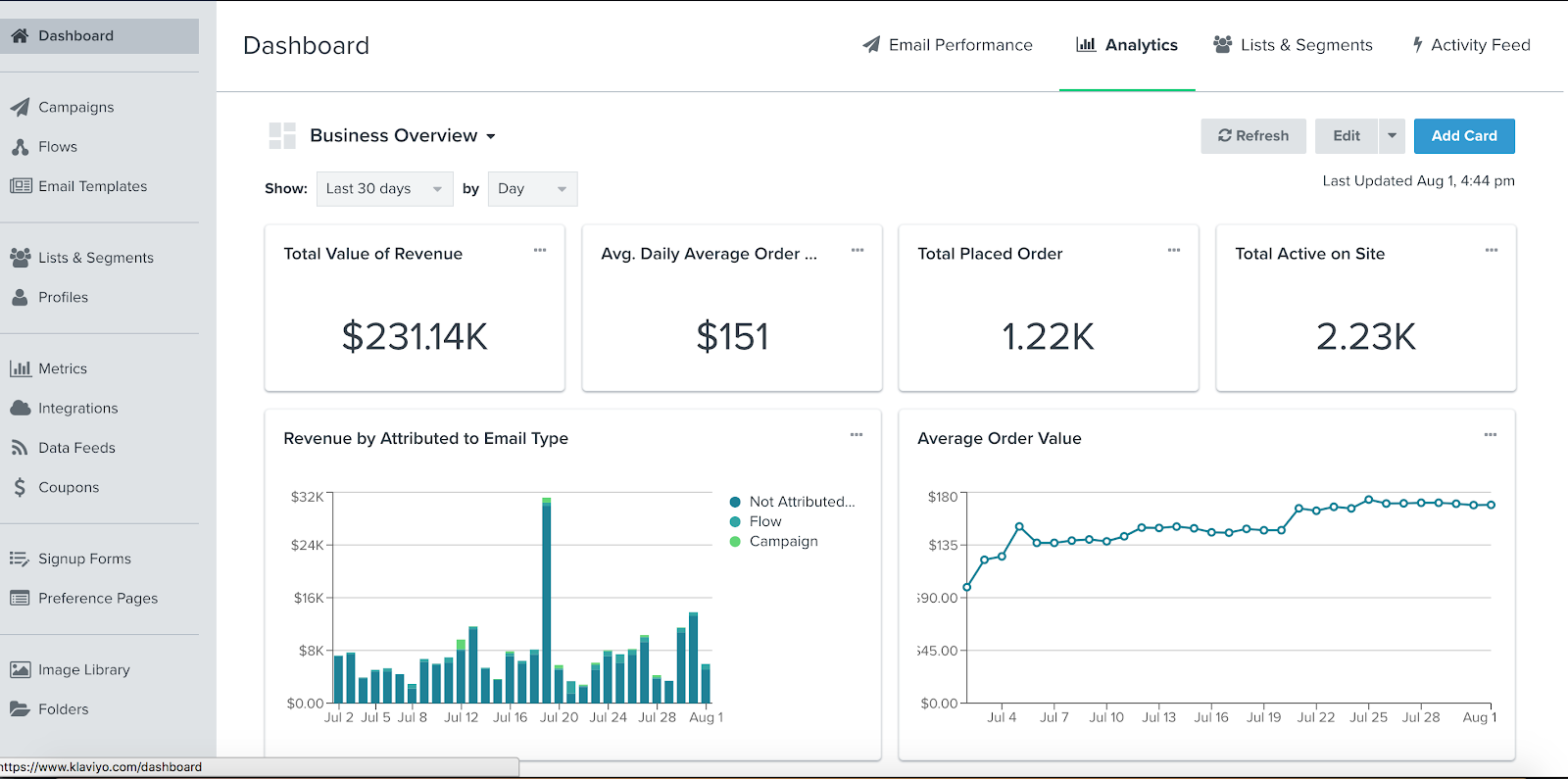
Some of our favourite Klaviyo features:
Powerful pre-built automations
Automate your email marketing touchpoints, such as welcome series and abandoned cart messages. Klaviyo provides a library of pre-built automations to help get you started, or alternatively, you can build your own in minutes.
Customer segmentation
Slice and dice your email list how you want to based on how they’ve interacted with you in the past. Intuitively move people through the funnel through tailored messages in order to build long-lasting relationships that maximise activation and retention.
Built for eCommerce
Unlike other email automation platforms, Klaviyo is strictly built for eCommerce, as demonstrated by its unrivalled integration with Shopify. Measure your results in revenue, not clicks or opens.
Power your Facebook and Google Ads audiences
One of our favourite Klaviyo features is the ability to automatically sync your customer data to ad platforms like Facebook and Google Ads. Rather than go through the laborious process of downloading and uploading customer lists, you can send your data directly between platforms and sync daily, to ensure freshness of data.
Omnisend
Like Klaviyo, Omnisend is an omnichannel marketing automation platform built for eCommerce. And although it comes with some advanced features, its pre-built email automation templates, amongst other features make it easy to use, even for beginners.

Mailchimp
Mailchimp is an all-in-one marketing platform that helps you create automation with lots of flexible settings and design options, as well as builder tools that walk you through every step of the process. Price-wise, it compares favourably to other options, however is lacking in features around automatic triggers and integration with Shopify. However, if you’re just getting started with email, it’s a useful platform to learn the basics, before moving onto something more powerful.

10. Use SMS To Engage With Existing Customers
SMS stand out as a direct communication channel as the average person receives far fewer text messages than emails in a day, they’re more likely to have their notifications turned on, and spam filters don’t exist for texts as they do for email.
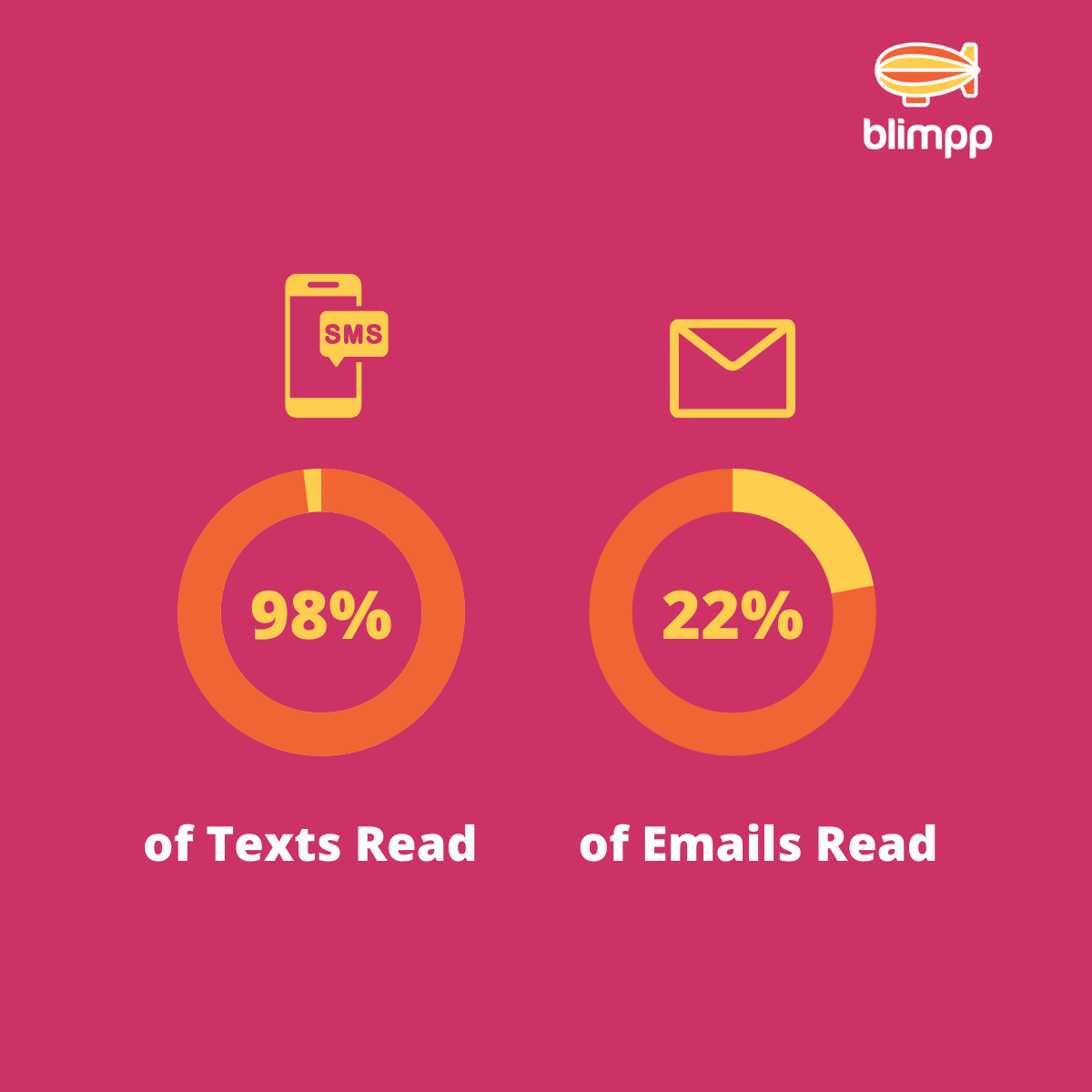
And with the number of SMS Shopify apps available, it’s now more accessible than ever.
However, as powerful as this channel can be as a marketing tool, due to the personal nature of the communication, getting it wrong can lead to unhappy customers and damaged customer trust.
Let’s look at some important dos and don’ts of the channel.
DO have a great offer
SMS offers high open rates, however, its disruptive nature means that it can also yield negative sentiment if an offer is deemed to be unsatisfactory. With that in mind, it makes sense to push noteworthy offers, rather than everyday promotions.
DO be clear and concise
Attention spans are short, so ensure that your message packs a punch in as few characters as possible. You have a maximum of 160 characters, and don’t have the benefit of imagery, so always be testing to find the right approach and keep your customers engaged.
DO track your SMS campaigns
Many SMS Shopify apps allow you to track campaigns in terms of engagement, however, ensure that you’re also tracking bottom-line revenue. One way of doing this is through UTM tagging, allowing you to see the overall value of your SMS activity in Google Analytics.
DO remind people how they opted in
Your customers might have forgotten that they opted-in to SMS, so it’s always useful to remind them how they opted-in initially. What’s more, give them the option to opt-out to ensure you’re staying compliant with data protection laws.
DON'T make SMS your first point of contact
SMS shouldn’t be your brand’s first point of contact. Use email as much as possible for initial communications, and SMS sparingly.
DON'T bombard customers with text messages
Related to the above point, it’s important to not over-use the channel, as this will likely result in higher opt-out rates and lower click-through.
Similar to email marketing, you can choose to send out SMS messages at specific trigger points. Using apps like Postscript, you can build customised automations using certain triggers and filters that allow you to provide customers with the most personalised offers possible. For example, when launching a new product, SMS can be a great way to generate awareness amongst your most engaged customers. Conveying a feeling of exclusivity, and being the first to know, can help to drive sales across a new product or range.
Analyse past customer behaviour to target those who may be interested, and be sure to reference why you think the new product would be a good fit for them, based on recent purchases.
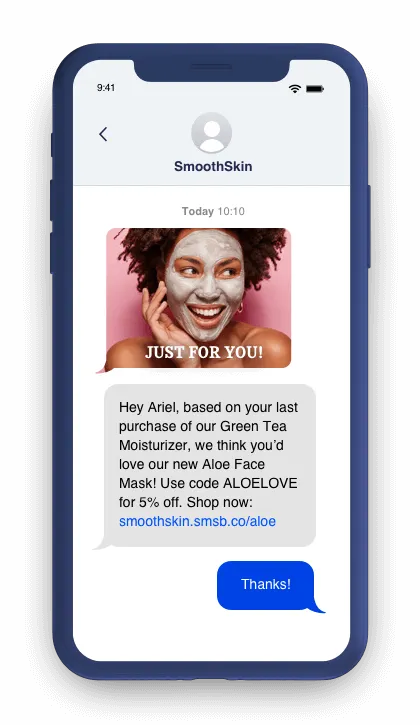
SMS Marketing Campaign Types
Understanding the do’s and don’t of SMS is critical, but the fundamentals of the channel are pretty similar to email: be there (at the right time), and be relevant. Here are a few examples of SMS campaigns in the wild that achieve just that.
Product Launch SMS: Doe Lashes
Lash brand Doe Lashes use SMS extensively when it comes to new product launches, and the informal nature of its texts goes a long way to sell without being “salesy”.
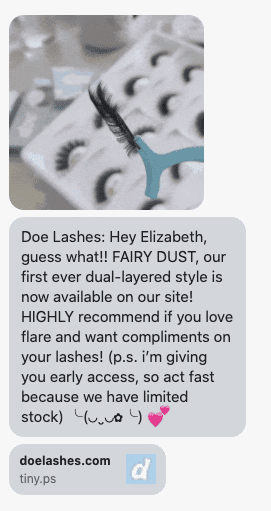
Cross-Sell & Up-Sell: NaturAll Club
Haircare brand NaturAll focus on tailor-made bundles (based on recent purchase behaviour) to drive incremental sales from the channel.
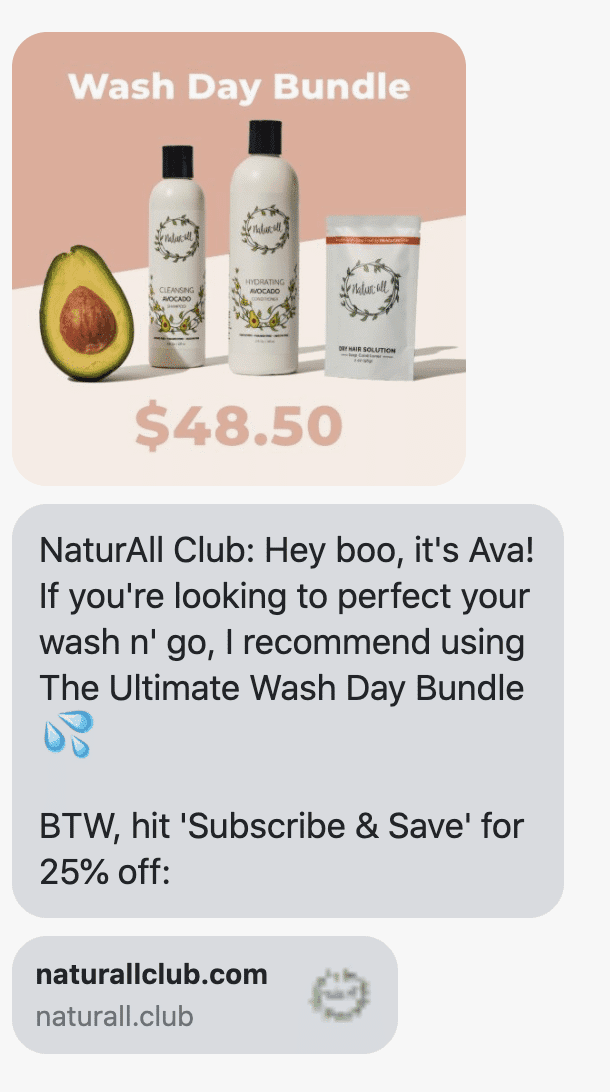
Pre-Order: Snow Teeth Whitening
Harnessing the power of your community to drive pre-orders can also be a worthwhile strategy when releasing new products. Teeth whitening brand Snow follow this path to drive early awareness of it’s toothpaste, throwing in a free gift to those who take them up on the offer.
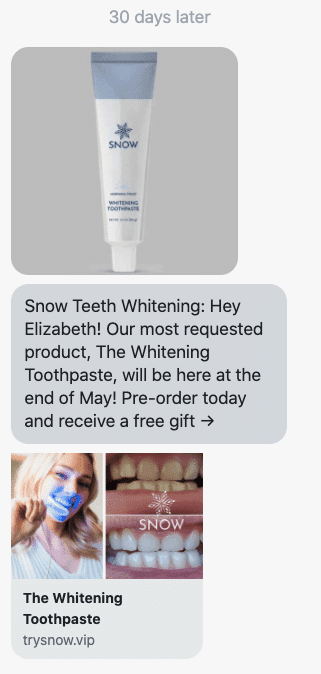
Summary
When trying to optimise your digital presence, the first thing to think about is how to get yourself in front of the right customers. Once you’re driving the right kind of traffic, you’ll want to optimise your conversion methods, and your choice of creative plays a big part here. This is an important stage as it directly affects your bottom line.
Examine your customers’ shopping behaviour so you can be present at the main touchpoints.
Invest in social media marketing, as influencers and third-party reviews are two key sources of information for “in-market” beauty shoppers.
From an on-site conversion perspective, make sure your website is mobile responsive, optimise website speed, improve site search, and include product recommendations to help users find products according to their needs.
Once you’ve acquired your customer, don’t simply forget about them. Extend customer Lifetime Value, using the power of email marketing and SMS. Numerous opportunities exist, specifically around automated flows, which adopt behavioural trigger points to target customers across critical phases of the customer lifecycle journey.
With so much to consider, to thrive in beauty and cosmetics eCommerce it’s important that you attack the challenge of growth with the right tools and technical know-how. Hopefully, this guide de-mystifies some of the core levers of growth and provides a roadmap to successful execution.
